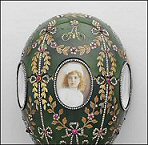1908 Alexander Palace Egg
Gift
Nicholas II to Alexandra Feodorovna
Made in Saint Petersburg
Owner: Kremlin Armoury Museum, Moscow
Height: 11 cm
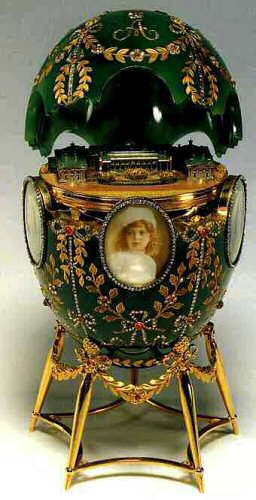
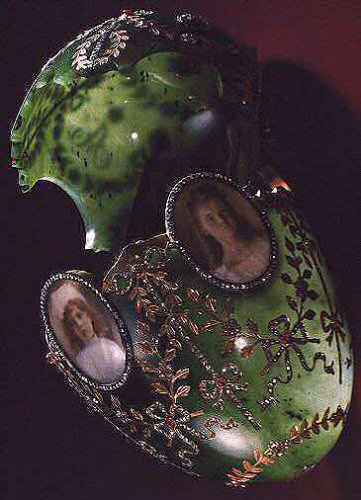
The 1908 Alexander Palace Egg is made of nephrite (a sort of jade), gold, portrait diamonds, rose-cut diamonds, rubies and watercolor on ivory. The surprise, the miniature Alexander Palace, is made of varicolored gold, silver, rock crystal, green enamel, wood and glass.
The nephrite Egg is adorned with five miniature watercolor portraits of the children of Emperor Nicholas II and contains a replica of Alexander Palace at Tsarskoye Selo. The upper and lower sections of the egg are set with triangular diamonds bearing the initial AF (Alexandra Feodorovna) and golden leaves and flowers composed of rubies and diamonds.
The remainder of the Egg's surface is divided by five vertical lines, studded with diamonds and connected with one another by gold garlands inlaid with rose and ruby flowers. In the spaces between the vertical lines are five miniature oval portraits of emperor Nicholas II's children, executed in watercolor. In a diamond monogram the first initial of the child represented. Inside the egg, on the reverse side of each portrait, is engraved the birth date of the person represented, framed by two branches tied into a bow: "Olga" - November 3, 1895; "Tatiana" - May 29, 1897; "Maria" - June 14, 1899; "Anastasia" - June 5, 1901; "Alexei" - July 30, 1904.
When opened, the Egg reveals a tiny detailed replica of Alexander Palace, the Imperial family's favorite residence at Tsarskoye Selo, and its adjoining gardens. It is executed in tinted gold and enamel, with windows of rock crystal; the roof is enameled in light green. The model is secured on a gold table with five high narrow legs. The inscription "The Palace at Tsarskoye Selo", enclosed in a laurel wreath, is engraved on the base.
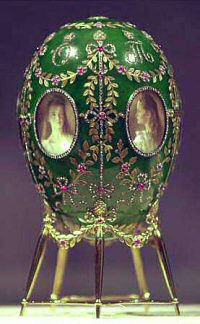
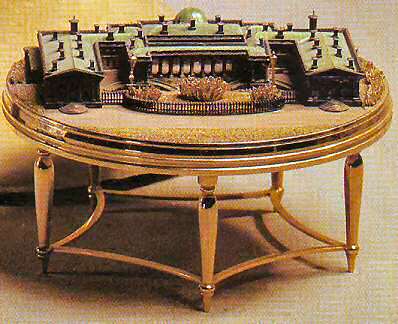
Left, Olga and Maria, right the Palace on its golden table
Background Information
The Invoice reads: "Nephrite egg with gold incrustations, 54 rubies and 1805 rose-cut diamonds, design with 2 diamonds and 5 miniatures of the Imperial children, containing a representation of the Alexander Palace in gold. St. Petersburg, 2 May 1908. 12,300 roubles."
1908-1917 - Kept in the Alexander Palace at Tsarskoye Selo. 1917 Confiscated by Kerensky's provisional government, along with other treasures, and taken from the Anchikov Palace to the Moscow Kremlin Armoury. The Alexander Palace Egg was never sold to the West and remained in Russia.
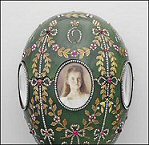
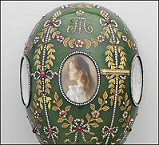
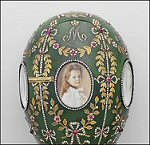
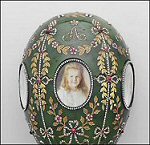
(Left to right, Olga, Tatiana, Maria, Anastasia and Alexei. (OTMAA as the children called themselves - Images courtesy Romanov News)
This Egg was another shrewd choice by Fabergé. The Alexander Palace was the Imperial family's favorite home, apart from the rather more informal palace Nicholas II would build at Livadia in the Crimea. Fabergé had use the "favored-residence theme" seven year earlier in the 1901 Gatchina Palace Egg for Maria Feodorovna.
The modern stand for the Egg was made in 1989 at the Moscow experimental jewelry factory. The original stand is lost. The velvet base of the Egg's original carrying case is preserved and for many years was used as the stand for it. (see picture)
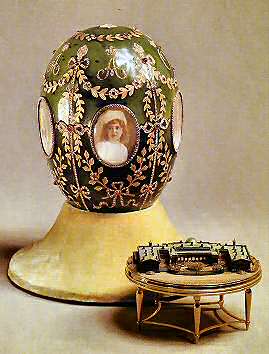
The Alexander Palace Egg in the velvet base
of its original carrying case
Page updated or corrected: April 1, 2018

